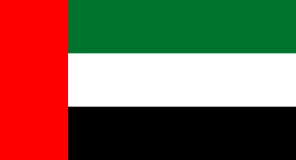United Arab Emirates
Green Hydrogen Vision
The United Arab Emirates (UAE) envisions green hydrogen as a cornerstone of its strategy to achieve net-zero emissions by 2050 and diversify its energy mix. The UAE aims to become a global leader in green hydrogen production and export by leveraging its abundant solar energy resources and advanced infrastructure. The country plans to integrate hydrogen into key sectors such as industry, transportation, and power generation, supporting decarbonisation and sustainable economic growth. The UAE also seeks to position itself as a regional hub for hydrogen innovation and trade, aligning its vision with global sustainability goals and its ambition to lead the energy transition in the Middle East.
National Strategy
The National Hydrogen Strategy 2050 seeks to enhance the UAE’s role as a low-emission hydrogen producer and supplier by 2031. To accomplish this, the UAE plans to develop supply chains, create hydrogen oases, and establish a national research and development centre focused on hydrogen technologies.
The strategy focuses on:
- cultivating the domestic market
- forming a regulatory framework and policies that promote hydrogen as a sustainable fuel for the future
- enhancing regional collaboration to create a regional hydrogen market and
- increasing investments in research and development to boost the cost efficiency of hydrogen production, transportation, and consumption.
This approach bolsters investor confidence and enables companies to establish strong supply chains. It aligns with the country's goals to fully leverage its plentiful solar energy and natural gas resources, enhance its carbon capture and storage capabilities, and take advantage of its strategic position to facilitate local hydrogen production and advance the global hydrogen economy.
Capacity Targets
The strategy aims to boost the global hydrogen economy and enhance local hydrogen production to reach:
- 1.4 million tons per annum (mtpa) by 2031, which includes 1 mtpa of green hydrogen and 0.4 mtpa of blue hydrogen.
- 7.5 mtpa by 2040; and
- 15 mtpa by 2050.
Infrastructure requirements include 15.3 GW solar PV capacity and 8.7 GW electrolyser capacity for green hydrogen.
Impact Targets
-
Environmental: Support decarbonisation across sectors, contributing to the UAE’s net-zero emissions goal by 2050.
-
Economic: Create a hydrogen economy that attracts foreign investment, generates local jobs, and enhances industrial competitiveness.
-
Energy Security: Establish the UAE as a global hydrogen hub, leveraging its infrastructure and geographic position to supply European and Asian markets.
Policy and Project Spotlight
- Abu Dhabi Future Energy Company (Masdar) has finalized agreements with Norwegian firms to investigate clean energy prospects, focusing on green hydrogen. The UAE firm established a strategic framework agreement with Equinor to boost cooperation on existing projects while considering new opportunities and enhancing the supply chain for current and upcoming initiatives. In addition, Masdar signed an agreement with ICP Infrastructure, an infrastructure fund manager associated with the Aker Group, to investigate partnership and investment options in green energy infrastructure across Europe, including potential renewable energy collaborations in the Nordic region.
- Masdar has also teamed up with Aker Horizons Asset Development to explore joint development and investment prospects in the ‘Power-to-Green Hydrogen’ value chain aimed at decarbonizing hard-to-abate sectors. Finally, the company agreed with Yara to explore collaborative and investment opportunities within the ‘Power-to-Green Ammonia’ value chain, centring on green hydrogen.
- Masdar, the UAE’s leader in clean energy, and EMSTEEL, the country’s most significant public steel and building materials firm, have completed a pilot project showcasing the utilisation of green hydrogen to manufacture green steel. Based in Abu Dhabi, this pioneering pilot is the first in the Middle East and North Africa to employ green hydrogen to extract iron from iron ore, which is essential for steel production. Now fully operational, the pilot project has launched the production of green steel.
Financing
- Investment: Significant funding will be directed toward clean energy projects, including hydrogen, with AED 600 billion allocated to renewable energy by 2050.
- Public-Private Partnerships: Collaboration with entities like ADNOC, Masdar, and TAQA to develop production, storage, and export facilities.
- Incentives: Policy and regulatory frameworks to attract investment and reduce early-mover risks in the hydrogen market.
Government Green Hydrogen Lead
Ministry of Energy and Infrastructure
